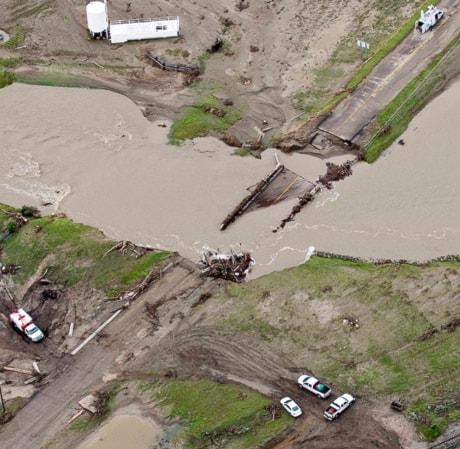MEDICINE HAT — Rain began falling yet again in southeastern Alberta on Monday, but concerns were diminishing that it would prompt the same destructive flooding that swept the area on the weekend.
Moisture forecasts in Medicine Hat were downgraded to 30 millimetres for the day — down from 70 mm that would likely have seen low-lying areas of the city inundated once again.
Fire chief Ronald Robinson admitted to feeling “somewhat relieved.”
“At this time, the South Saskatchewan River is flowing lower than was anticipated, so we don’t believe that the same impact will occur as was experienced this weekend.”
Residents of about 600 homes were still on alert and roughly 230 houses were placed on voluntary evacuation notice, he said.
It was relief tempered with caution as Environment Canada issued severe weather warnings for most of southern Alberta, including the southeast, which has been soaked with 150 mm of rain over the last several days.
The rain was expected to taper off in Alberta on Tuesday and move into Saskatchewan, where Environment Canada issued severe thunderstorm warnings for southwestern Saskatchewan and extended weather watches east past Regina. The storms could produce rainfall totalling 50 mm or so in one hour.
A tornado warning was also issued Monday for Gravelbourg and Assiniboia in south-central Saskatchewan. There were reports of funnel clouds and even of one tornado touching down, along with hail and heavy rain.
In addition, lightning struck oil tanks in a field near Gull Lake, igniting them and sending huge plumes of black smoke into the sky.
There were no reports of injuries.
Alberta Agriculture Minister Jack Hayden, who took an aerial tour Monday, said many areas remain underwater.
“We obviously have concerns,” he said. “The ground is saturated out there, the areas that will hold water are full of water, so the rain events that we get now, my concern is it’s going to cause those tributaries to build up again.”
The Trans-Canada Highway was still closed between Medicine Hat and Maple Creek, Sask., one of the hardest hit areas in that province.
Hayden said he was told the highway was pock-marked by sinkholes and covered with rushing water in places. It’s unknown when it might reopen.
About 5,000 vehicles use that stretch of highway every day, and drivers are being forced to take a 200-kilometre detour.
“It’s a priority, but the problem (is) this is an unprecedented event in this area,” Hayden said. “No one’s ever seen it. We have no historic records of tributaries doing what they’re doing right now, so until the event’s over, it can be evaluated and the repairs done, we’re in a waiting mode.”
The above-average precipitation on the Prairies means farmers could come out the long-term losers. Hayden said he’s been in constant consultation with his counterparts in Manitoba and Saskatchewan, where millions of hectares are too soggy to seed.
Producers will probably turn to the federal government to ask for help, he said.
“We’re in the middle of it right now. It’ll probably be another week or two before we can even survey the damage,” Hayden said. “We have to get some of that water moved off so we can see what we’ve lost for crops.”
Saskatchewan Premier Brad Wall toured the areas hit hard in his province, including Maple Creek, where torrents rushed down the streets on Friday and washed piles of debris and thick muck into homes.
“It’s a major disaster for the town. There’s no question about it,” said Wall.
He said cleanup comes first, but the provincial government will be ready with financial aid. “We’re going to be doing whatever we can as quickly as we can to help out.”
Doug Wakabayashi with the Saskatchewan Highways Ministry said both westbound lanes of the Trans-Canada just west of Maple Creek were destroyed and one of the eastbound lanes was also gone.
He said crews were working feverishly to fix the eastbound lanes temporarily to enable at least a single line of traffic to pass in each direction.
It could take a month to do the complete rebuild, however, and more rain could be a problem, he said.
“While the information we’re getting right now is that the rainfall won’t impact the flooding situation, rain impacts highway construction. (If it rains), it could be slower.”
Meanwhile, in western Manitoba, areas were still trying to recover from heavy rain that washed out roads and bridges. At least one rural municipality declared a state of emergency on Friday and another was considering a similar move.
Reeve Edward Levandoski from the RM of Rosedal, north of Neepawa, said officials were still trying to access the full extent of the damage. He said repairs costs will likely be at least half a million dollars in his area alone.
Rain continued to slow efforts to make roads passable.
Also on Monday, Water Stewardship Minister Christine Melnick toured Killarney, Man., which had declared a state of emergency on the weekend.
“It had been very heavily flooded right down the main street,” she said. “Water was lapping up into many of the businesses along the main street.”
The Portage diversion was reopened on Monday to divert water around the Brandon area.
— With files from Jennifer Graham in Regina, CJGP in Neepawa, Man., and CTV Winnipeg, CTV Regina
